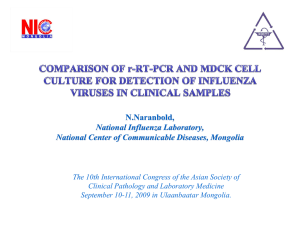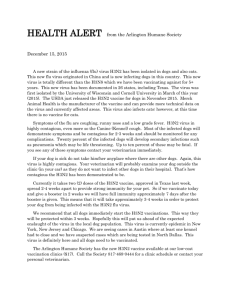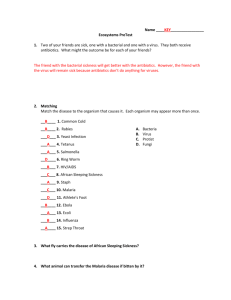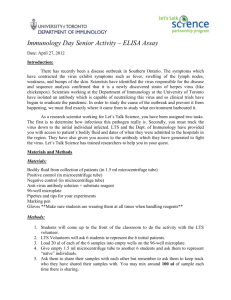EFFECTS OF Cryptolepis buchanani EXTRACTS ON INFLUENZA A
advertisement
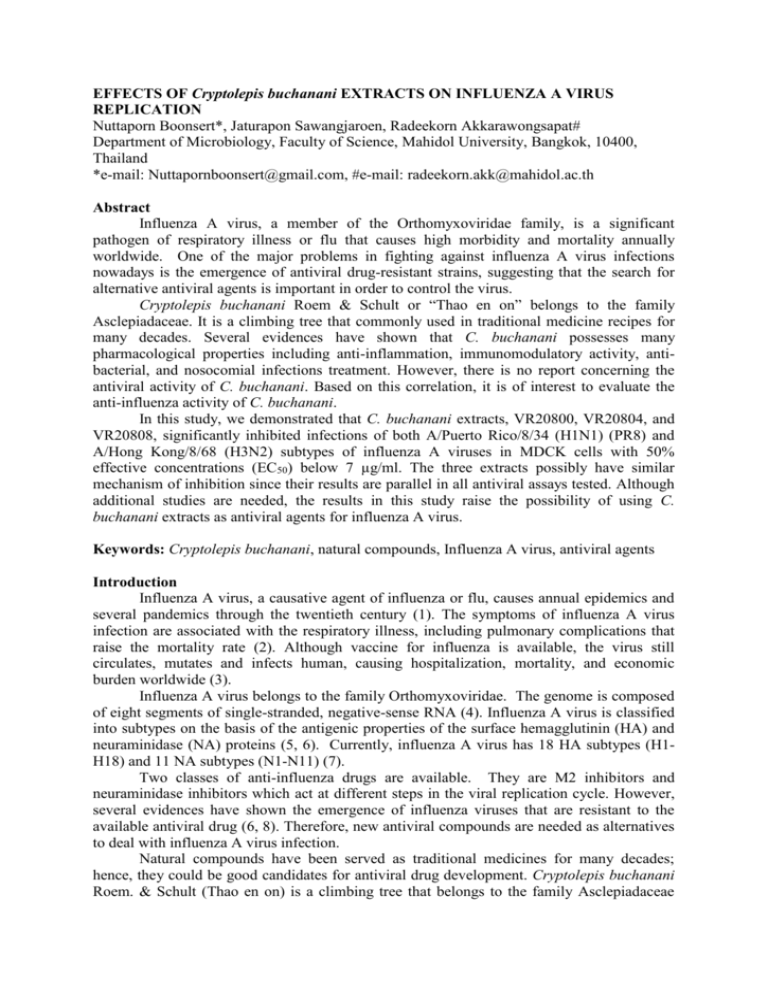
EFFECTS OF Cryptolepis buchanani EXTRACTS ON INFLUENZA A VIRUS REPLICATION Nuttaporn Boonsert*, Jaturapon Sawangjaroen, Radeekorn Akkarawongsapat# Department of Microbiology, Faculty of Science, Mahidol University, Bangkok, 10400, Thailand *e-mail: Nuttapornboonsert@gmail.com, #e-mail: radeekorn.akk@mahidol.ac.th Abstract Influenza A virus, a member of the Orthomyxoviridae family, is a significant pathogen of respiratory illness or flu that causes high morbidity and mortality annually worldwide. One of the major problems in fighting against influenza A virus infections nowadays is the emergence of antiviral drug-resistant strains, suggesting that the search for alternative antiviral agents is important in order to control the virus. Cryptolepis buchanani Roem & Schult or “Thao en on” belongs to the family Asclepiadaceae. It is a climbing tree that commonly used in traditional medicine recipes for many decades. Several evidences have shown that C. buchanani possesses many pharmacological properties including anti-inflammation, immunomodulatory activity, antibacterial, and nosocomial infections treatment. However, there is no report concerning the antiviral activity of C. buchanani. Based on this correlation, it is of interest to evaluate the anti-influenza activity of C. buchanani. In this study, we demonstrated that C. buchanani extracts, VR20800, VR20804, and VR20808, significantly inhibited infections of both A/Puerto Rico/8/34 (H1N1) (PR8) and A/Hong Kong/8/68 (H3N2) subtypes of influenza A viruses in MDCK cells with 50% effective concentrations (EC50) below 7 µg/ml. The three extracts possibly have similar mechanism of inhibition since their results are parallel in all antiviral assays tested. Although additional studies are needed, the results in this study raise the possibility of using C. buchanani extracts as antiviral agents for influenza A virus. Keywords: Cryptolepis buchanani, natural compounds, Influenza A virus, antiviral agents Introduction Influenza A virus, a causative agent of influenza or flu, causes annual epidemics and several pandemics through the twentieth century (1). The symptoms of influenza A virus infection are associated with the respiratory illness, including pulmonary complications that raise the mortality rate (2). Although vaccine for influenza is available, the virus still circulates, mutates and infects human, causing hospitalization, mortality, and economic burden worldwide (3). Influenza A virus belongs to the family Orthomyxoviridae. The genome is composed of eight segments of single-stranded, negative-sense RNA (4). Influenza A virus is classified into subtypes on the basis of the antigenic properties of the surface hemagglutinin (HA) and neuraminidase (NA) proteins (5, 6). Currently, influenza A virus has 18 HA subtypes (H1H18) and 11 NA subtypes (N1-N11) (7). Two classes of anti-influenza drugs are available. They are M2 inhibitors and neuraminidase inhibitors which act at different steps in the viral replication cycle. However, several evidences have shown the emergence of influenza viruses that are resistant to the available antiviral drug (6, 8). Therefore, new antiviral compounds are needed as alternatives to deal with influenza A virus infection. Natural compounds have been served as traditional medicines for many decades; hence, they could be good candidates for antiviral drug development. Cryptolepis buchanani Roem. & Schult (Thao en on) is a climbing tree that belongs to the family Asclepiadaceae (9). According to Ayurveda, C. buchanani has been known as Indian folk medicine that used for treatment of diarrhea, inflammation, bacterial infection, ulcerative, coughing, lactation in women, rickets in children, and blood purification (10). In Thailand, C. buchanani is commonly used in folk medicine recipes for the treatment of inflammation conditions such as arthritis, and bone and joint pain (11, 12). Regardless of the knowledge described by several cultures, C. buchanani has been tested and shown to possess various pharmacological properties including anti-inflammation, immunomodulatory activity, anti-bacterial, and nosocomial infections treatment (9, 10, 13). Although various therapeutic properties are reported, none has examined antiviral property, if any, of C. buchanani. In this study, effects of C. buchanani extracts on influenza A virus replication are investigated. We demonstrate that C. buchanani extracts, VR20800, VR20804, and VR20808, exhibit inhibitory activities against both A/Puerto Rico/8/34 (H1N1) (PR8) and A/Hong Kong/8/68 (H3N2) subtypes of influenza A viruses in MDCK cells. The effective concentrations that show inhibition at least 50% (EC50) were determined. The results of this study could provide information about novel function of C. buchanani as anti-influenza agents and support the use of medicinal plants as alternative medicine. Methodology Cell line and virus Madin-Darby canine kidney (MDCK) cells were cultured in minimal essential medium (MEM) supplemented with 10% heat-inactivated fetal bovine serum (FBS) and antibiotics (100 U/ml Penicillin and 100 µg/ml Streptomycin) at 37ºC in 5% CO2 atmosphere. Human influenza virus strains A/Puerto Rico/8/34 (H1N1) (PR8) and A/Hong Kong/8/68 (H3N2) were propagated in MDCK cells. Cryptolepis buchanani extracts Three fractions of Cryptolepis buchanani extracts in ethyl acetate (EtOAc), named as VR20800, VR20804, and VR20808, were kindly provided by Associate Professor Dr. Patoomratana Tuchinda (Mahidol University, Thailand). All extracts were dissolved in DMSO at a stock concentration of 20 mg/ml and stored at -20ºC. Cytotoxicity Assay Overnight culture of MDCK cells (2 × 104 cells/well) in 96-well plates were washed with MEM supplemented with antibiotics and then treated with 2-fold serially diluted C. buchanani extracts at the indicated concentrations or mock control (MEM with antibiotics) at 37ºC and 5% CO2 for overnight. Twenty µl of the CellTiter 96 Aqueous One Solution Reagent (Promega, Madison, WI) was added to all tested wells and the plates were incubated at 37ºC for 90 minutes. Then, optical density (OD) was measured at wavelength 492 nm by ELISA plate reader (Tecan, Austria). Antiviral assays All antiviral assays were done by plaque reduction assay. Various concentrations of C. buchanani extracts, VR20800 (0.78-25 µg/ml), VR20804 (1.56-25 µg/ml), and VR20808 (0.156-5 µg/ml) were tested in four antiviral assays: comprehensive antiviral assay, pretreatment assay, simultaneous assay, and post-entry assay. These four assays are different at the time C. buchanani extracts were present, which are at all time of the assay, prior to infection, during infection, and post infection, respectively. Comprehensive antiviral assay MDCK cells (6 × 105 cells/ml) in a 6-well plate for overnight were washed with MEM supplemented with antibiotics and then treated with diluting media (MEM with 0.2% BSA and antibiotics) alone or indicated concentrations of C. buchanani extracts for 1 hour at 37ºC. Then, the medium was discarded, and MDCK cells were infected with the influenza A virus strain PR8 or H3N2 (40 PFU/well) in the presence of C. buchanani extracts at 37ºC for 1 hour. After infection, C. buchanani extract-virus mixture was discarded, and infected MDCK cells were treated with plaque mixture solution (1.2% Avicel, 1X MEM, 0.22% NaHCO3, 0.21% BSA, 0.01 M HEPES, 2 mM glutamine, 0.01% DEAE-dextran, (100 U/ml Penicillin and 100 µg/ml Streptomycin), and 2 µg/ml TPCK-trypsin) in the presence of C. buchanani extracts. After incubation at 37ºC for 2 days, the infected cells were washed with PBS and treated with 3.7% formaldehyde for 1 hour at room temperature. To visualize plaques, each well of infected cell monolayer was stained with 1.5 ml of 1.25% crystal violet for 10 minutes at room temperature and washed with tap water. Numbers of plaque formation were counted and plaque forming unit (PFU) was calculated. Pre-treatment assay In a 6-well plate, confluent MDCK cells were washed with MEM supplemented with antibiotics and treated with diluting media alone or various concentrations of C. buchanani extracts at 37ºC for 1 hour. Then, pre-treatment solution was removed and the cells were washed with diluting medium and infected with PR8 or H3N2 (40 PFU/well) at 37ºC for 1 hour. After infection, C. buchanani extracts-virus mixture was discarded and MDCK cells were treated with plaque mixture solution at 37ºC for 2 days. Plaques were visualized and counted as described above. Simultaneous assay Confluent MDCK cells were washed once with washing media (MEM with antibiotics). Then, the cells were infected with PR8 or H3N2 (40 PFU/well) in the presence of various concentrations of C. buchanani extracts at 37ºC for 1 hour. Subsequently, C. buchanani extracts-virus mixture was discarded and MDCK cells were treated with plaque mixture solution at 37ºC for 2 days. Plaques were visualized and counted as described above. Post-entry assay Confluent MDCK cells were washed once with washing media. Then, the cells were infected with PR8 or H3N2 (40 PFU/well) for 1 hour. Subsequently, the virus was discarded and infected MDCK cells were treated with plaque mixture solution in the presence of various concentrations of C. buchanani extracts at 37ºC for 2 days. Plaques were visualized and counted as described above. Results Cryptolepis buchanani extracts inhibited both PR8 and H3N2 influenza A virus replication Initially, eleven Cryptolepis buchanani extracts, named VR20799-20809, were screened for their ability to inhibit influenza A virus strains A/Puerto Rico/8/34 (H1N1) (PR8) and A/Hong Kong/8/68 (H3N2) replication in Madin-Darby canine kidney (MDCK) cells by comprehensive antiviral assay. In this assay, various concentrations of C. buchanani extracts (0.156 – 12.5 µg/ml) were present at all time of the assay so that cumulative effects would be observed. Based on the ability to inhibit influenza A virus replication, VR20800, VR20804, and VR 20808 were selected for further experiments. In the screening comprehensive antiviral assay, cytotoxic effects on MDCK were observed starting at concentrations of 6.25 µg/ml for VR20800, 12.5 µg/ml for VR20804, and 1.25 µg/ml for VR20808 (data not shown). As a consequence, the comprehensive assay was rerun with concentrations of C. buchanani extracts lower than cytotoxic concentration. The tested concentrations were adjusted to 0.78-6.25 µg/ml for VR20800, 1.56-12.5 µg/ml for VR20804, and 0.156-1.25 µg/ml for VR20808. All three C. buchanani extracts significantly reduced PR8 and H3N2 virus titers at the highest concentrations tested compared to no extract control (Figure 2). The results showed that the C. buchanani extracts inhibited both PR8 and H3N2 replication in a dose-dependent manner. The effective concentrations that show inhibition at least 50% (EC50) were determined (Table 1). VR20808 is the most effective, inhibiting both PR8 and H3N2 viruses with EC50 values of 0.625 µg/ml and 1.25 µg/ml, respectively. Treatment of VR20800, VR20804, and VR20808 prior to infection did not protect cells from infection To determine whether VR20800, VR20804, and VR20808 provided cellular protection, MDCK cells were pre-treated with various concentrations of the extracts for 1 hour and rinsed prior to infection with the influenza viruses. Pre-treatment of the cells with all three extracts did not significantly reduce virus titers even at the concentrations higher than that tested in the comprehensive assay (Figure 1). The results suggested that the C. buchanani extracts were inactive when they were present prior to virus infection. Treatment of VR20800, VR20804, and VR20808 during infection reduced viral replication Simultaneous assay was performed to determine whether VR20800, VR20804, and VR20808 could inhibit influenza A virus infection at the same time of infection. Various concentrations of VR20800, VR20804, or VR20808 were incubated simultaneously with either PR8 or H3N2 virus infection for 1 hour. The EC50 values are summarized in Table 1. As shown in Figure 1, VR20800 reduced both PR8 and H3N2 viral titers by approximately 44% and 50%, respectively, at the highest concentration tested (25 µg/ml). Similar to VR20800, VR20804 showed the concentration-dependent reduction of PR8 and H3N2 virus replication, inhibiting approximately 50% at highest concentration tested (25 µg/ml). The same tendency applied to VR20808, reducing PR8 and H3N2 virus titers by 16 and 36%, respectively, at the highest concentration tested (5 µg/ml). These results suggest that all three C. buchanani extracts had some effects at early event of virus infection. Post-entry treatment of VR20800, VR20804, and VR20808 showed reduction of PR8 virus but not H3N2 virus To address whether the inhibitory effect seen was a result of post-entry event, various concentrations of VR20800, VR20804, or VR20808 were added after removal of PR8 or H3N2 virus from MDCK cell monolayer that had been infected for 1 hour. The extracts were incubated further for 2 days. Due to the long incubation period, the extract concentrations were prepared similar to that in the comprehensive assay. As shown in Figure 2, all three extracts reduced PR8 virus titer in a dose-dependent manner. At the highest concentration tested, post-entry treatment of infected MDCK cells with VR20800 (6.25 µg/ml), VR20804 (12.5 µg/ml) and VR20808 (1.25 µg/ml) significantly reduce viral titer by approximately 80%, 70%, and 65%, respectively. Interestingly, inhibition of H3N2 virus replication was not seen when the infected cells were treated with the extracts after they had been infected for 1 hour. These results suggest that the inhibitory mechanisms of the C. buchanani extracts against PR8 and H3N2 infection are different. Discussion and Conclusion Nowadays, natural compounds are well-known for their roles as prophylaxis and therapeutic agents for many diseases. Cryptolepis buchanani or “Thao en on” is a natural herbal plant that is shown to possess various pharmacological properties and thus has been used as a remedy in folk medicine for many decades (10-12). However, little is known about its antiviral property. Here, we demonstrate that C. buchanani extracts, VR20800, VR20804, and VR20808, possess inhibitory activities against influenza A virus replication in MDCK cells. This study provides the first available data for anti-influenza property in C. buchanani. Dose-response studies illustrated that VR20800, VR20804, and VR20808 blocked both A/Puerto Rico/8/34 (H1N1) (PR8) and A/Hong Kong/8/68 (H3N2) infection with EC50 values ranging from as low as 0.625 to 6.25 µg/ml when the extracts were present in the entire assay period. In addition, when the extracts were present at some time points of the assay (i.e. pre-treatment, simultaneous, and post-treatment assays), they displayed parallel pattern of inhibitory activities, suggesting that the mechanism of inhibition among the extracts could be similar. These results also indicate that the compound compositions in the extracts may be analogous one another. However, further studies to find out active components in the extracts are needed in order to confirm the presumption. The fact that all three C. buchanani extracts have no effect on reducing PR8 and H3N2 virus titers in the pre-treatment assay suggests that the extracts have no effect on the cells. Therefore, using of C. buchanani extracts as prophylaxis agents may not be useful for viral control. In contrast to the pre-treatment assay, results obtained from the simultaneous assay showed the concentration-dependent reduction of PR8 and H3N2 virus titers. Although VR20808 appeared to show slight inhibition of both virus subtypes compared to the results of others, these inhibitory activities are not account for all antiviral activities since the EC 50 values are essentially higher than those observed in the comprehensive assay. These results suggest that all three C. buchanani extracts had some effects at early event of virus infection. The possibility that the extracts block infection at the attachment step is inconclusive as they did not prevent infection when they were treated with the cells before infection and a specific attachment assay is required. Due to the long incubation period similar to that in the comprehensive assay, the same concentrations of VR20800, VR20804, and VR20808 were tested in post-entry assay. Results observed in the post-entry assay were unexpected. All three extracts inhibited PR8 by reducing virus titer in a dose dependent manner. However, the extracts had no inhibitory effect on H3N2 virus infection in the post-entry assay. These results suggest that the inhibitory mechanisms of the C. buchanani extracts against PR8 and H3N2 infection are different. It is possible that PR8 and H3N2 modulate different cellular signaling pathways to successfully infect the host cell (14). Additional studies in order to determine the mechanism of inhibition are required. Plaque assay was used for quantification of the viral infectivity in all antiviral assays tested in this study. Besides reduction in plaque number, reduction in plaque size is observed as well (data not shown). Viral plaque size was significantly decreased for both PR8 and H3N2 in a dose-dependent manner compared to no extract control in the assays with long incubation period, i.e. post-entry assay and comprehensive antiviral assay (data not shown). These suggest the role of C. buchanani extracts to interfere both PR8 and H3N2 virus replication process when the extracts are present for a long time. Although the H3N2 virus titer was not significantly inhibited in post-entry assay but the decrease of plaque size formation is obviously observed. A possible explanation could be that the extracts interfere the functions of viral proteins necessary for replication, resulting in reduction of the virus replication rate. The differences in genetic background among PR8 and H3N2 virus may be involved (15). In summary, we demonstrate that C. buchanani extracts possess antiviral activities against influenza A virus infection. The steps in infection that the extracts act remain to be elucidated further. The fact that all three extracts tested in this study are crude extracts, which contain a variety of components derived from extraction process, identification and purification of the extracts would likely lead to the active compounds that could potentially be developed as an alternative influenza A virus inhibitor. PR8 H3N2 140 140 120 120 100 80 ** * 60 40 Virus Titer (%) Virus Titer (%) A) 100 * * 80 * 60 40 20 20 0 0 0 3.125 6.25 12.5 25 Concentrations (µg/ml) 0 3.125 6.25 12.5 25 Concentrations (µg/ml) B) 140 Virus Titer (%) Virus Titer (%) 120 100 80 60 40 20 0 0 160 140 120 100 80 60 40 20 0 * * 0 3.125 6.25 12.5 25 Concentrations (µg/ml) ** 3.125 6.25 12.5 25 Concentrations (µg/ml) 140 140 120 120 Virus Titer (%) Virus Titer (%) C) 100 80 60 40 20 * 100 80 ** 60 40 20 0 0 0 0.625 1.25 2.5 Concentrations (µg/ml) 5 0 0.625 1.25 2.5 5 Concentrations (µg/ml) Figure 1. The effect of VR20800 (A) , VR20804 (B) , and VR20808 (C) in pre-treatment assay (black bar) in comparison with simultaneous assay (lined bar) on A/Puerto Rico/8/34 (H1N1) (PR8) and A/Hong Kong/8/68 (H3N2) infection. In the pre-treatment assay, various concentrations of the C. buchanani extracts were added to MDCK cells for 1 hour and rinsed before infection with the viruses for 1 hour. In the simultaneous assay, the extracts were present during infection with the viruses for 1 hour. Virus titers were determined by plaque assay. Each data point represents the mean from three independent experiments. Error bars represent the standard deviations of the means (*, P < 0.05; **, P < 0.01). PR8 H3N2 120 140 100 120 Virus Titer (%) Virus Titer (%) A) 80 60 ** 40 ** ** 20 * 80 60 ** 40 20 ** 0 0 100 0 0.78 1.56 3.125 6.25 Concentrations (µg/ml) 0 0.78 1.56 3.125 6.25 Concentrations (µg/ml) B) 140 120 100 Virus Titer (%) Virus Titer (%) 120 * 80 * 60 40 ** 20 100 80 * 60 40 ** 20 ** 0 0 0 1.56 3.125 6.25 12.5 Concentrations (µg/ml) 0 1.56 3.125 6.25 12.5 Concentrations (µg/ml) C) 100 * 80 60 * ** 40 20 ** 0 0 0.156 0.3125 0.625 1.25 Concentrations (µg/ml) Virus Titer (%) Virus Titer (%) 120 160 140 120 100 80 60 40 20 0 * 0 0.156 0.3125 0.625 1.25 Concentrations (µg/ml) Figure 2. The effect of VR20800 (A) , VR20804 (B) , and VR20808 (C) in post-entry assay (black bar) in comparison with comprehensive antiviral assay (lined bar) on A/Puerto Rico/8/34 (H1N1) (PR8) and A/Hong Kong/8/68 (H3N2) infection. In the post-entry assay, various concentrations of the C. buchanani extracts were added to MDCK cells after being infected with the viruses for 1 hour and were incubated further for 2 days. In the comprehensive assay, the extracts were present at all times of the assay. Virus titers were determined by plaque assay. Each data point represents the mean from three independent experiments. Error bars represent the standard deviations of the means (*, P < 0.05; **, P < 0.01). Table 1. Summary of 50% effective concentrations (EC50) of VR20800, VR20804 and VR20808 in various antiviral assays EC50 (µg/ml) Compounds VR20800 VR20804 VR20808 Pre-treatment assay PR8 H3N2 > 25 > 25 > 25 > 25 >5 >5 Simultaneous assay PR8 > 25 > 25 >5 H3N2 25 25 >5 Post-entry assay PR8 6.25 12.5 1.25 H3N2 > 6.25 > 12.5 > 1.25 Comprehensive antiviral assay PR8 H3N2 1.56 6.25 6.25 6.25 0.625 1.25 References 1. 2. 3. 4. 5. 6. 7. 8. 9. 10. 11. 12. 13. 14. 15. Neumann G, Noda T, Kawaoka Y. Emergence and pandemic potential of swine-origin H1N1 influenza virus. Nature. 2009;459(7249):931-9. Epub 2009/06/16. Dolin R. Influenza. In: D.L. Longo, A.S. Fauci, D.L. Kasper, S.L. Hauser, J.L. Jameson, Loscalzo J, editors. Harrison's Principles of Internal Medicine. New York: McGraw-Hill; 2012. p. 9-15. Ludwig S, Planz O, Pleschka S, Wolff T. Influenza-virus-induced signaling cascades: targets for antiviral therapy? Trends in molecular medicine. 2003;9(2):46-52. Epub 2003/03/05. Medina RA, Garcia-Sastre A. Influenza A viruses: new research developments. Nature reviews Microbiology. 2011;9(8):590-603. Epub 2011/07/13. Butel JS. Orthomyxoviruses (Influenza Viruses). In: Geo. F. Brooks KCC, Janet S. Butel, Stephen A. Morse, Timothy A. Mietzner, editor. Jawetz, Melnick, & Adelberg's Medical Microbiology. 25 ed: The McGraw-Hill Companies; 2010. p. 536-49. Kawaoka Y, Neumann G. Influenza viruses: an introduction. Methods Mol Biol. 2012;865:1-9. Epub 2012/04/25. Tong S, Zhu X, Li Y, Shi M, Zhang J, Bourgeois M, et al. New world bats harbor diverse influenza a viruses. PLoS pathogens. 2013;9(10):e1003657. Epub 2013/10/17. Monto AS. The role of antivirals in the control of influenza. Vaccine. 2003;21(16):1796-800. Epub 2003/04/11. Laupattarakasem P, Wangsrimongkol T, Surarit R, Hahnvajanawong C. In vitro and in vivo antiinflammatory potential of Cryptolepis buchanani. Journal of ethnopharmacology. 2006;108(3):349-54. Epub 2006/07/13. Kaul A, Bani S, Zutshi U, Suri KA, Satti NK, Suri OP. Immunopotentiating properties of Cryptolepis buchanani root extract. Phytotherapy research : PTR. 2003;17(10):1140-4. Epub 2003/12/12. Laupattarakasem P, Houghton PJ, Hoult JR, Itharat A. An evaluation of the activity related to inflammation of four plants used in Thailand to treat arthritis. Journal of ethnopharmacology. 2003;85(2-3):207-15. Epub 2003/03/18. Panthong A, Kanjanapothi D, Taylor WC. Ethnobotanical review of medicinal plants from Thai traditional books, Part I: Plants with anti-inflammatory, anti-asthmatic and antihypertensive properties. Journal of ethnopharmacology. 1986;18(3):213-28. Epub 1986/12/01. Sittiwet CaDP. Anti-bacterial activity of Cryptolepis buchanani aqueous extract. International Journal of Biological Chemistry. 2009;3(2):90-4. Liqian Zhu, Hinh Ly, Liang Y. PLC-gamma1 signaling plays a subtype-specific role 1 in post-binding cell entry of Influenza A virus. J Virol. 2013. Epub 23 October 2013. Huang SS, Banner D, Fang Y, Ng DC, Kanagasabai T, Kelvin DJ, et al. Comparative analyses of pandemic H1N1 and seasonal H1N1, H3N2, and influenza B infections depict distinct clinical pictures in ferrets. PloS one. 2011;6(11):e27512. Epub 2011/11/24. Acknowledgements We would like to thank Associate Professor Dr. Patoomratana Tuchinda (Mahidol University, Thailand) for providing the C. buchanani extracts, Assistant Professor Arunee Thitithanyanont (Mahidol University, Thailand) and Suwimon Wiboon-ut for great supports throughout the research work.
